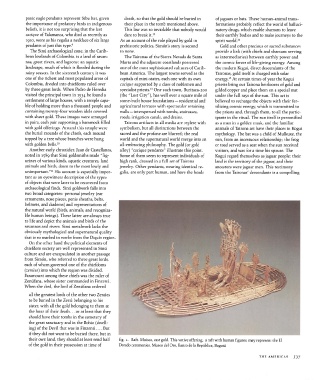Page 538 - Art In The Age Of Exploration (Great Section on Chinese Art Ming Dynasty)
P. 538
panic eagle pendants represent Sibu but, given death, so that the gold should be buried in of jaguars or bats. These human-animal trans-
the importance of predatory birds in indigenous their place in the tomb mentioned above. formations probably reflect the world of halluci-
beliefs, it is not too surprising that the last This law was so inviolable that nobody would natory drugs, which enable shamans to leave
cacique of Talamanca, who died as recently as dare to break it. 12 their earthly bodies and to make journeys to the
1910, wore as his regalia a necklace of six large As an account of the role played by gold in spirit world. 14
pendants of just this type. 9 prehistoric politics, Simon's story is second Gold and other precious or sacred substances
The Sinu archaeological zone, in the Carib- to none. provide a link (with chiefs and shamans serving
bean lowlands of Colombia, is a land of savan- The Taironas of the Sierra Nevada de Santa as intermediaries) between earthly power and
nas, great rivers, and lagoons: an aquatic Marta and the adjacent coastlands possessed the cosmic forces of life-giving energy. Among
landscape, much of which is flooded during the one of the most sophisticated cultures of Carib- the modern Kogui, direct descendants of the
rainy season. In the sixteenth century it was bean America. The largest towns served as the Taironas, gold itself is charged with solar
one of the richest and most populated areas of capitals of mini-states, each one with its own energy. At certain times of year the Kogui
15
Colombia, divided into chiefdoms ruled over cacique supported by a class of noblemen and priests bring out Tairona heirlooms of gold and
by three great lords. When Pedro de Heredia specialist priests. One such town, Buritaca-ioo gilded copper and place them on a special mat
13
visited the principal town in 1534 he found a (the "Lost City"), has well over a square mile of under the full rays of the sun. This act is
settlement of large houses, with a temple capa- stone-built house foundations — residential and believed to recharge the objects with their fer-
ble of holding more than a thousand people and agricultural terraces with spectacular retaining tilizing cosmic energy, which is transmitted to
containing twenty-four wooden idols covered walls —interspersed with tombs, staircases, the priests and, through them, to all the partic-
with sheet gold. These images were arranged roads, irrigation canals, and drains. ipants in the ritual. The sun itself is personified
in pairs, each pair supporting a hammock filled Tairona artifacts in all media are replete with as a man in a golden mask, and the familiar
with gold offerings. Around this temple were symbolism, but all distinctions between the animals of Tairona art have their places in Kogui
the burial mounds of the chiefs, each mound sacred and the profane are blurred; the real mythology. The bat was a child of Mulkuxe, the
topped by a tree whose branches were hung world and the supernatural world merge into an sun, from an incestuous relationship; the frog
with golden bells. 10 all-embracing philosophy. The gold (or gold or toad served as a seat when the sun received
Another early chronicler, Juan de Castellanos, alloy) "cacique pendants" illustrate this point. visitors, and was for a time his spouse. The
noted in 1589 that Sinu goldsmiths made "fig- Some of them seem to represent individuals of Kogui regard themselves as jaguar people; their
urines of various kinds, aquatic creatures, land high rank, dressed in a full set of Tairona land is the territory of the jaguar, and their
animals and birds, down to the most lowly and jewelry. Other pendants, wearing identical re- ancestors were jaguar men. This testimony
11
unimportant/' His account is especially impor- galia, are only part human, and have the heads from the Taironas' descendants is a compelling
tant as an eyewitness description of the types
of objects that were later to be recovered from
archaeological finds. Sinu goldwork falls into
two broad categories: personal jewelry (ear
ornaments, nose pieces, penis sheaths, belts,
helmets, and diadems) and representations of
the natural world (birds, animals, and recogniza-
ble human beings). These latter are always true
to life and depict the animals and birds of the
savannas and rivers. Sinu metalwork lacks the
obviously mythological and supernatural quality
that is so marked in works from the Diquis region.
On the other hand the political elements of
chiefdom society are well represented in Sinu
culture and are encapsulated in another passage
from Simon, who referred to three great lords,
each of whom governed one of the chiefdoms
(zenues) into which the region was divided.
Paramount among these chiefs was the ruler of
Zenufana, whose sister commanded in Finzenu.
When she died, the lord of Zenufana ordered
all the greatest lords of the other two Zenues
to be buried in the Zemi belonging to his
sister, with all the gold belonging to them at
the hour of their death... or at least that they
should have their tombs in the cemetery of
the great sanctuary and in the Bohio (dwell-
ing) of the Devil that was in Finzenu But
if they did not want to be buried there, but in
their own land, they should at least send half fig. 2. Raft. Muisca, cast gold. This votive offering, a raft with human figures, may represent the El
of the gold in their possession at time of Dorado ceremonies. Museo del Oro, Banco de la Republica, Bogota
THE AMERICAS 537

